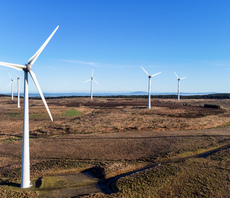Renewables provided over half Northern Ireland’s electricity in 2022, data shows


Official data shows 51 per cent of Northern Ireland’s power consumption came from renewables last year, but RenewableNI warns investment in clean power is stalling
More than half the electricity used in Northern Ireland last year came from renewables, marking the highest level for a calendar year since records began 10 years ago, official data released yesterday shows.
From January to December 2022, 51 per cent of Northern Ireland’s power consumption on average was provided by locally-based renewable electricity sources such as wind and solar, according to the Northern Ireland Executive.
The performance marks a near 10 per cent increase on the same period in 2021, and is the second-highest average proportion for renewables on record for a 12-month period, just behind the 51.6 per cent achieved between December 2021 to November 2022, Department for the Economy (DfE) data shows.
Northern Ireland also set a new monthly record for clean power in 2022, generating an average of 76.5 per cent of its electricity from renewables during a particularly blustery February last year.
Across the year as a whole, the majority of the country’s renewable electricity came from wind power, which supplied 85.3 per cent of its renewables, marking a slight uptick from the 82.1 per cent measured in 2021.
The remainder of Northern Ireland’s renewable electricity supplies last year came from biogas (5.5 per cent), biomass (4.1 per cent), and solar (3.2 per cent), all of which showed little change from previous years.
Steven Agnew, the director of clean energy trade association RenewableNI, said the latest data showed Northern Ireland was heading in a positive direction towards its recently-adopted target to source 80 per cent of its electricity from renewables by 2030, but that there was still a long way to go.
“While it is fantastic to see the renewable electricity generation achieve over 50 per cent for the first time, we need to more than double the generation to achieve the 80 per cent target by 2030,” he said. “For the last four years Northern Ireland has stalled investment in the sector. We have achieved 1.7GW capacity – we need an additional 2.5GW, but only 75MW a year of new generation has been connected.”
Agnew warned that, with power sharing in the Northern Ireland Assembly still suspended with elections currently delayed until next year, it remained difficult to put forward or amend policy in support of ramping up renewables capacity in the country.
“The legislative environment has not created optimum conditions for this much needed investment during this time so we are relying heavily on outputs from established renewable sources which have been onstream for some years,” he said.
However, there are hopes that the UK government’s deal with the EU over the Northern Ireland Protocol could help pave the way to a new power sharing government that could in turn lead to progress on climate and clean energy policy in the country, which operates a separate electricity system to the rest of the UK.
Last week, the UK’s Climate Change Committee published its assessment of Northern Ireland’s “very tough” 2050 net zero emissions target, concluding that the country may need to pursue more “speculative” carbon removal technologies as well as a major decrease in livestock farming in order to stand a chance of reaching the goal.
Chris Stark, CEO of the CCC, said last week that the Northern Ireland Protocol deal “may pave the way to a return to a power sharing government that can implement the policies needed under this new target”. said Stark. “We’ll need that,” he added.
Some renewable electricity policy plans are still moving forward in Northern Ireland at present however, with the Department for the Economy issuing a statement of intent in January to collaborate with the Crown Estate on leasing further areas of the seabed for new offshore wind farms.
Even so, Agnew warned that the planning system was continuing to slow the development of new renewables projects.
“It’s taken two to five years to get a wind farm through planning when really, we should be able to do that within 12 months,” he told the Belfast Telegraph. “We’re in a climate emergency; we need speed, we need urgency and we’re not seeing that from our policy environment or our planning system.”
He added: “We need a planning system that can make decisions quickly, and allow us to build out the new generation needed to meet our 2030 and 2035 targets.”















